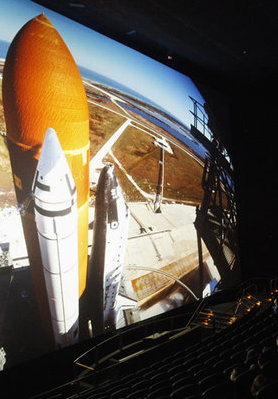Friday, May 8, 1987.
THE DREAM IS ALIVE. Written by Tony Myers. Music by Micky Erbe and Maribeth Solomon. Directed by Graeme Ferguson. Running time: 37 minutes. General entertainment.
A DEEP BREATH.
I know that everything about IMAX is designed to be impressive, but I can suppress my sense of awe.
Must make light. I remember how, 41 years ago [1946], directors Michael Powell and Emeric Pressburger opened their movie Stairway to Heaven with a quick tour of the cosmos.
The CN IMAX Theatre, operated during Expo 86 as part of the Canada Pavilion, is dominated by a 50 x 70-foot screen. Seeing it, I recall how Stairway's stentorian narrator summed up the universe.
“Big, isn't it?"
IMAX, the high-fidelity motion picture presentation system designed and developed by Canada's IMAX Systems Corporation, is big. Indeed, it's the biggest movie format in existence, a system that excites both enthusiasm and superlatives.
IMAX cameras take pictures that are 10 times larger than their 35mm counterparts. IMAX theatres benefit from a screen image that is proportionally bigger, brighter and more lifelike than standard commercial films.
During Expo 86, the CN IMAX Theatre made movie history by premiering the 3D-IMAX process. More than 1,740,000 fairgoers saw director Colin Low's Transitions, and took home vivid memories of falling eggs and a floating teddy bear.
This afternoon [May 8, 1987], when the theatre reopens as Vancouver's newest cinema, another bit of corporate history will be recorded. Though more than 50 IMAX-equipped sites are currently in operation worldwide, the CN IMAX is the first to be directly managed by the Toronto-based company.
Inside, there is new seating — 485 individual seats have replaced the upholstered benches used during last year's fair — and there's a new attraction: a journey into orbit called The Dream Is Alive.
Anticipation now. On hand for Wednesday evening's preview screening was NASA shuttle commander Vance Brand. “I can't really see this movie enough times,” said the veteran astronaut.
“It's just like being in space. ''
Produced and directed by the IMAX company's founding father Graeme Ferguson, the 37-minute picture includes footage shot by various astronauts on missions aboard the
Space Shuttles Discovery and Challenger using a space-rated IMAX camera. As an heroic theme wells up on the surround-stereo soundtrack, the familiar voice of Walter Cronkite announces that “this is the Kennedy Space Centre, America's spaceport.”
For the first few minutes, it is possible to keep awe in check. Then Ferguson's camera zeroes in on the first of three spectacular shuttle launches.
Suddenly, we're 280 miles up. Our view of the living planet is magnificent in its detail and clarity. It is stunning in a way that TV or still pictures can never be, and awesome — yes, awesome — because we know that this is no studio-made special effect.
It's real and it's breathtaking. Designed as a tribute to NASA's manned space program (and now dedicated to the lost Challenger crew), The Dream Is Alive shares with us something of the experience of a brave and special few.
The above is a restored version of a Province review by Michael Walsh originally published in 1987. For additional information on this archived material, please visit my FAQ.
Afterword: The loss of the Space Shuttle Challenger was still fresh in the public mind when The Dream Is Alive opened in Vancouver. Shuttle launches were major news events in 1986, and so millions of viewers saw its January 28 explosion live on television. The disaster cost the lives of seven astronauts, five men and two women. The U.S. shuttle program went into hiatus as the government awaited the report of the Presidential Commission appointed to investigate the cause of its “ascent failure.” NASA’s dream came alive again in September 1988, when Discovery lifted off on its seventh mission.
Vance Brand, who spoke at the film’s Vancouver screening, had been the mission commander on Challenger’s fourth flight in February, 1984. Two of the astronauts seen in the film, Francis Scobee and Judith Resnick, had died aboard the Challenger, so a movie conceived as a celebration of IMAX in orbit became a eulogy to those lost in pursuit of the space-exploration dream.
Among the great chroniclers of America’s Shuttle program was Canadian filmmaker Graeme Ferguson. An inventor and co-founder of the IMAX Corporation, Ferguson directed the 1982 documentary Hail Columbia!, a record of the maiden voyage of the first shuttlecraft. It was the beginning of Ferguson’s three-decade-long relationship with the National Aeronautics and Space Administration. In 1984, he provided NASA with specially-built IMAX cameras that its astronauts used during their flights to produce the spectacular footage seen in The Dream Is Alive. After the Shuttle program resumed, the IMAX cameras returned to space. To date, Ferguson has produced six additional films in cooperation with NASA — Blue Planet (1990); Destiny in Space (1994); Mission to Mir (1997); Space Station 3D (2002); Hubble 3D (2010) and A Beautiful Planet (2016).
